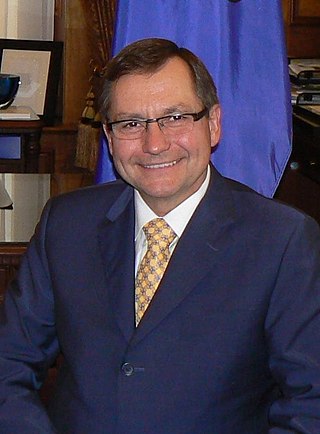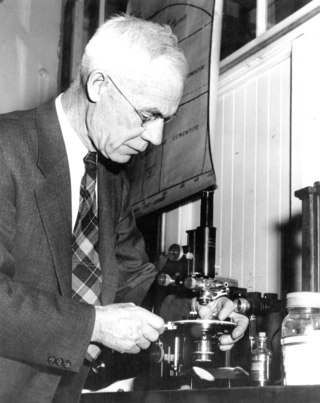
Edgar Peter Lougheed was a Canadian lawyer and Progressive Conservative politician who served as the tenth premier of Alberta from 1971 to 1985, presiding over a period of reform and economic growth.

The Canadian Association of Petroleum Producers (CAPP), with its head office in Calgary, Alberta, is a lobby group that represents the upstream Canadian oil and natural gas industry. CAPP's members produce "90% of Canada's natural gas and crude oil" and "are an important part of a national industry with revenues of about $100 billion-a-year ."

Alberta separatism comprises a series of 20th- and 21st-century movements advocating the secession of the province of Alberta from Canada, either by joining the United States, forming an independent nation or by creating a new union with one or more of Canada's western provinces. The main issues driving separatist sentiment have been the perceived power disparity relative to Ottawa and other provinces, historical grievances with the federal government dating back to the unrealized Province of Buffalo, a sense of distinctiveness with regards to Alberta's unique cultural and political identity, and Canadian fiscal policy, particularly as it pertains to the energy industry.
The Ministry of Energy is a Cabinet-level agency of the government of the Canadian province of Alberta responsible for coordinating policy relating to the development of mineral and energy resources. It is also responsible for assessing and collecting non-renewable resource (NRR) royalties, freehold mineral taxes, rentals, and bonuses. The Alberta Petroleum Marketing Commission, which is fully integrated with the Department of Energy within the ministry, and fully funded by the Crown, accepts delivery of the Crown's royalty share of conventional crude oil and sells it at the current market value. The current ministry was formed in 1986, but ministries with other names dealing with energy resources go back to the Ministry of Lands and Mines in 1930.

Edward Michael Stelmach is a Canadian politician who served as the 13th premier of Alberta, from 2006 to 2011. The grandson of Ukrainian immigrants, Stelmach was born and raised on a farm near Lamont and fluently speaks the distinctive Canadian dialect of Ukrainian. He spent his entire pre-political adult life as a farmer, except for some time spent studying at the University of Alberta. His first foray into politics was a 1986 municipal election, when he was elected to Lamont County council. A year into his term, he was appointed reeve. He continued in this position until his entry into provincial politics.

Karl Adolf Clark was a chemist and oil sand researcher. He is best known for perfecting a process that uses hot water and reagents to separate bitumen from oil sands.

Canada has access to all main sources of energy including oil and gas, coal, hydropower, biomass, solar, geothermal, wind, marine and nuclear. It is the world's second largest producer of uranium, third largest producer of hydro-electricity, fourth largest natural gas producer, and the fifth largest producer of crude oil. In 2006, only Russia, the People's Republic of China, the United States and Saudi Arabia produce more total energy than Canada.

The Alberta Heritage Savings Trust Fund(HSTF) is a sovereign wealth fund established in 1976 by the Government of Alberta under then-Premier Peter Lougheed. The Heritage Savings Trust Fund was created with three objectives: "to save for the future, to strengthen or diversify the economy, and to improve the quality of life of Albertans." The operations of the Heritage Savings Trust Fund are subject to the Alberta Heritage Savings Trust Fund Act and with the goal of providing "prudent stewardship of the savings from Alberta's non-renewable resources by providing the greatest financial returns on those savings for current and future generations of Albertans." Between 1976 and 1983 the Government of Alberta deposited a portion of oil revenue into the fund. The Heritage Savings Trust Fund used oil revenues to invest for the long term in such areas as health care, education and research and as a way of ensuring that the development of non-renewable resources would be of long-term benefit to Alberta. The strategy and goals of the fund have changed through successive provincial governments which moved away from direct investments in Alberta to a diversified approach, which now includes stocks, bonds, real estate and other ventures.
Expenditures by federal and provincial organizations on scientific research and development accounted for about 10% of all such spending in Canada in 2006. These organizations are active in natural and social science research, engineering research, industrial research and medical research.
Crown corporations in Canada are government organizations with a mixture of commercial and public-policy objectives. They are directly and wholly owned by the Crown.
The Energy Resources Conservation Board (ERCB) was an independent, quasi-judicial agency of the Government of Alberta. It regulated the safe, responsible, and efficient development of Alberta's energy resources: oil, natural gas, oil sands, coal, and pipelines. Led by eight Board members, the ERCB's team of engineers, geologists, technicians, economists, and other professionals served Albertans from thirteen locations across the province.

The Alberta Geological Survey (AGS), founded in 1921, is the official provincial geological survey of Alberta, Canada and currently operates as a division within the Alberta Energy Regulator. The AGS provides geological information and advice about the geology of Alberta to the Government of Alberta, the Alberta Energy Regulator (AER), industry, and the public to support the exploration, sustainable development, regulation, and conservation of Alberta's resources.

Clement Willis Bowman was a Canadian chemical engineer, the founding chairperson of the Alberta Oil Sands Technology and Research Authority. He was a Member of the Order of Canada and a recipient of the Global Energy Prize.
Project Oilsand, also known as Project Oilsands, and originally known as Project Cauldron, was a 1958 proposal to exploit the Athabasca Oil Sands in Alberta via the underground detonation of up to 100 nuclear explosives; hypothetically, the heat and pressure created by an underground detonation would boil the bitumen deposits, reducing their viscosity to the point that standard oilfield techniques could be used.
The Alberta Oil Sands Technology and Research Authority (AOSTRA) was an Alberta crown corporation to promote the development and use of new technology for oil sands and heavy crude oil production, and enhanced recovery of conventional crude oil. It was funded by the Alberta Heritage Savings Trust Fund. Its head office and information centre were located in Edmonton, Alberta and a second office in Calgary, Alberta in Canada.
The Alberta Enterprise Group (AEG) is a member-based, non-profit business and corporate advocacy organization based in Edmonton, Alberta, Canada.

The Alberta Energy Regulator (AER) is a Canadian crown corporation responsible for regulating the development of energy resources in Alberta. Headquartered in Calgary, Alberta, the AER's mandate under the Responsible Energy Development Act (REDA), passed on 10 December 2012 and proclaimed on 17 June 2013, is to provide safe, efficient, orderly, and environmentally responsible development of energy resources in the province.
The Ministry of Environment and Protected Areas of Alberta is the Alberta provincial ministry of the Executive Council of Alberta responsible for environmental issues and policy as well as some, but not all, parks and protected areas in Alberta.
Alberta Biodiversity Monitoring Institute (ABMI) is an agency that monitors and reports on biodiversity status throughout the province of Alberta, Canada, that is funded equally by the government of Alberta and the oil and gas industry. The Alberta Biodiversity Monitoring Institute is based in Edmonton, Alberta. According to Alberta Innovates-Technology Futures (AITF), a key partner in the ABMI, the ABMI, which acts as "an early warning system by monitoring the cumulative effects of biodiversity change in regions throughout Alberta" is "the largest project of its kind ever attempted in Canada." Collaborating agencies include the government-industry research agency Alberta Innovates-Technology Futures, the University of Alberta, University of Calgary and the Royal Alberta Museum. Along with the Alberta Forest Management Planning Standard, the ABMI are key components to implementing resource planning based on ecosystem management principles. Alberta Environment and Parks consults the Alberta Biodiversity Monitoring Agency's reports in monitoring and preservation of species, setting benchmarks for biodiversity for land use plans. If industry contributes to the endangerment of a species that falls below these benchmarks, the Government of Alberta can order remedial action.
The Canadian province of Alberta faces a number of environmental issues related to natural resource extraction—including oil and gas industry with its oil sands—endangered species, melting glaciers in banff, floods and droughts, wildfires, and global climate change. While the oil and gas industries generates substantial economic wealth, the Athabasca oil sands, which are situated almost entirely in Alberta, are the "fourth most carbon intensive on the planet behind Algeria, Venezuela and Cameroon" according to an August 8, 2018 article in the American Association for the Advancement of Science's journal Science. This article details some of the environmental issues including past ecological disasters in Alberta and describes some of the efforts at the municipal, provincial and federal level to mitigate the risks and impacts.











